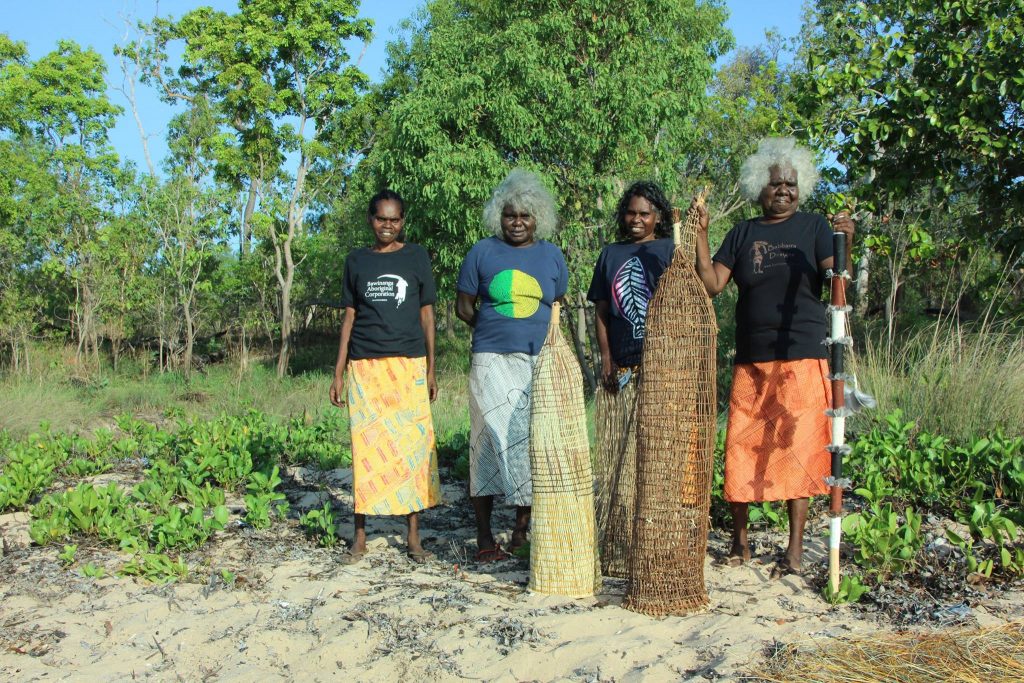
Babbarra women Jennifer, Phyllis, Deborah and Lennie on the Maningrida beach – Photo Babbarra Women’s Centre
Kuninjku people traditionally make two sorts of conical fish traps. One is called mandjabu and is made from a strong, durable vine called milil, and a smaller one is called manylik mandjabu, and made from the grass manylik. The mandjabu conical fish trap is bigger and stronger and used in tidal reaches of creeks to catch large fish. The smaller, lighter manylik trap is used in freshwater flowing creeks to catch smaller fish and freshwater prawns. In earlier times, only men were involved in the construction of the large fish traps, but children would often crawl inside and assist.
To make mandjabu, weavers firstly harvest milil (burney vine, Malaisia scandens) and put it in water overnight to make it soft. Then they start weaving it; they make rings for the inside to keep the fish trap’s shape. People also make string from the bark of burdaga (kurrajong) to attach the bardainy (hibiscus) rings and to tie the conical end of the fish trap. It’s hard work and it can take three or four weeks to make a fish trap. People also use fish-net fences called kunkarlewabe. They would put the kunkarlewabe across rivers and creeks. In the middle they would place the mandjabu. They also used small things like sticks, rocks, mud and grass to block the fish from going through. This way we would catch fish such as saltwater barramundi rajarra, ngaldadmurrng (freshwater barramundi), small black freshwater catfish (buliya), bonefish (an-guwirrpiya), and sand bass (dalakan) in the mandjabu.
SOURCE: Bábbarra Women’s Centre
Mandjabu (Fish trap / Nasse à poissons)
Les Kuninjku fabriquent traditionnellement deux sortes de pièges à poissons coniques. L’un s’appelle ‘mandjabu’ et est fabriqué à partir d’une vigne solide et durable appelée milil, et un plus petit s’appelle ‘manylik mandjabu’ et est fait à partir de l’herbe manylik. Le piège à poissons conique Mandjabu est plus grand et plus solide, et est utilisé dans les zones de marée des ruisseaux pour capturer les gros poissons. Le piège Manylik, plus petit et plus léger, est utilisé dans les ruisseaux d’eau douce pour capturer les plus petits poissons et les crevettes d’eau douce. Autrefois, seuls les hommes étaient impliqués dans la construction des grands pièges à poissons, mais les enfants rampaient souvent à l’intérieur et aidaient.
Pour fabriquer le mandjabu, les tisserands récoltent tout d’abord le milil (vigne burney, Malaisia scandens) et le laissent dans l’eau toute une nuit pour le rendre souple. Puis ils commencent à le tisser; ils font des anneaux pour l’intérieur afin de conserver la forme du piège à poisson. Les gens fabriquent également des ficelles à partir de l’écorce de burdaga (kurrajong) pour attacher les anneaux de bardainy (hibiscus) et pour attacher l’extrémité conique du piège à poisson. C’est un travail ardu et il faut parfois trois ou quatre semaines pour fabriquer un piège à poisson. Les gens utilisent également des clôtures en filet à poissons appelées kunkarlewabe. Ils mettent le kunkarlewabe à travers les rivières et les ruisseaux. Au milieu ils placent le mandjabu. Ils ont également utilisé de petites choses comme des bâtons, des roches, de la boue et de l’herbe pour empêcher le poisson de passer. De cette façon, ils attrapent des poissons tels que le barramundi d’eau salée rajarra, le ngaldadmurrng (barramundi d’eau douce), le petit poisson-chat noir d’eau douce (buliya), le bonefish (an-guwirrpiya) et le loup de mer (dalakan), grace au mandjabu.
SOURCE: Bábbarra Women’s Centre
